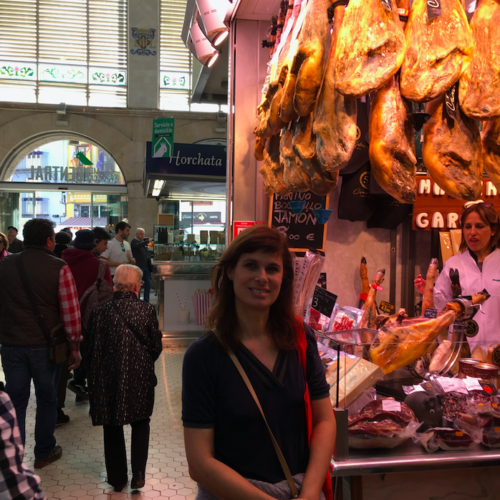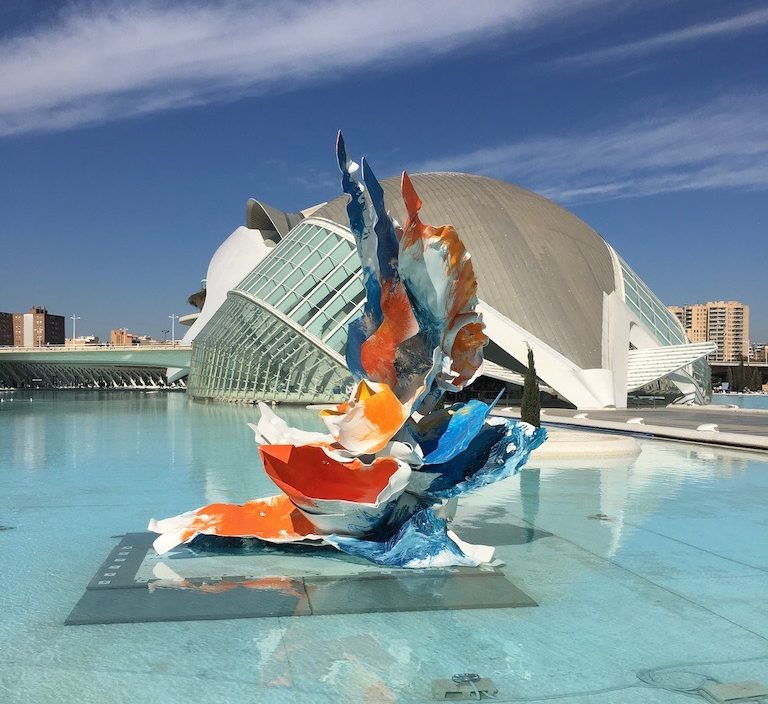Author:
Travel photographer, Inge Pincket @ingepincket and destinationexplorer.world.
Valencia is the third largest city of Spain (after Madrid and Barcelona). It almost never rains, (300 days without any rain) and the average temperature is 20°C. In the old city centre, you can find several UNESCO World heritage sites. I’ve visited Valencia twice now and would love to go again. What makes this city so special? The weather of course, almost always sunny, the delicious food and drinks, the beautiful architecture (both modern and old), the atmosphere and of course the beach. What more do you need?
Here’s my top 5 in sunny Valencia:
The City of Arts and Sciences:
Created at the southeast end of the former riverbed of the river Turia this place was turned into a park and is famous for its cultural and architectural complex, designed by the famous architect Santiago Calatrava. The park (Jardín del Turia) is a nice place to escape from the city centre and enjoy nature, culture and architecture. I chose to rent a bike in the city centre and cycled through the City of Arts and Sciences all the way to the beach. The bike trails link up well with bike paths in the city centre. Bike rental is about 9 € for one day.
What to visit?
L’Umbracle a gardened esplanade and exhibition zone with beautiful views
The Hemisfèric which holds a Large-format cinema, IMAX Dome.
Oceanogràfic nice to visit if you are travelling with kids with the largest aquarium in Europe. Admission price: 23,30€ for adults, children under four years are free.
Besides these 3, you also have ‘The Museum of Sciences’, the ‘Palau des Les Arts’ (the opera house of Valencia) and ‘The Agora’ (an event hall used for concerts, conventions and international sporting events). Apart from Oceanogràfic, I only saw the outside architecture of the other buildings. But you can buy a combined ticket to go in Oceanografic, Hemisfèric and the Museum of Sciences for 29 €.
Food Markets:
Valencia is a paradise for foodies. There are several food markets and I recommend two: The Central Market and Colón Market. I couldn’t resist them.
Mercado Central, Plaça de la Ciutat de Bruges, Valencia.
You need to visit this market, not only for the beautiful Art Nouveau building, but also to see the amazing amount of fresh local products that are sold there. It’s one of the oldest running food markets in Europe and was completed in 1928. I couldn’t stop admiring the beautiful high dome and the decorative ceramic tiles on the floor. If you’re staying somewhere with your own kitchen, you can definitely find all the ingredients to make the local speciality: Paella Valenciana. Did you know that this traditional dish was invented in Valencia? Click here for the recipe.
Mercado Colon, Carrer de Jorge Juan, 19, Valencia.
This market is no longer a working fresh market, but the building is absolutely worth visiting. It’s a beautiful Art Nouveau building opened in 1916. I sat on the terrace at one of the many bars and restaurants andordered the famous local cocktail: Aqua di Valencia (made of orange juice, cava, vodka, gin and sugar). A must try!
Or if you are not into alcohol, I recommend another local drink: Horchata at one of the Horchata refreshments stalls. Horchata is a fresh vegan milky drink made of tiger nuts (a root vegetable, known to be a super food) water and sugar.
I recommend ‘Horchatería de Santa Catalina’, Plaza Santa Catalina, 6. One of the oldest horchaterías in Valencia. Besides having a horchata with churros or fartons (another local sweet delicacy), you can enjoy the traditional decorated interior with beautiful ceramic tiles.
Old City Centre:
I’ve always had a weakness for the old cobblestoned streets in medieval cities. Strolling around in the heart of Valencia was one of my favourite things to do. Don’t miss the UNESCO World Heritage sites here: ‘La Lonja de la Seda’ (Silk Exchange), ‘El Tribunal de las Aguas’ (Water Tribunal) and Las Fallas (Carnaval).
La Lonja de la Seda, Carrer de la Llotja, 2, Valencia.
This masterpiece of Valencian gothic architecture was built in the late 15th century. You can find this building in front of the Central Market. The entrance is free. A must see is the main hall (Sala de Contratación) for the numerous twisting columns and the details of the vaulted ceilings.
El Tribunal de las Aguas, the Door of the Apostles, near the Cathedral.
The centuries-old tradition can be witnessed every Thursday at 12:00 sharp (except on public holidays).
The Water Tribunal, of the plain of Valencia, is the oldest law court in Europe. Although it was quite crowded, it was a great opportunity to go back in time with black smock dressed, elected farmers, sitting in a circle on 17th century chairs. The decisions they make are still binding.
Las Fallas, Plaza Del Ayuntamiento, Valencia. This festival is held yearly in March, starting with a daily Mascletà. I was lucky to be there in March 2019 and witness the Mascletà from a terrace on the 5th. La Mascletà is an ear-splitting firework display which can be seen and heard every day at 2pm during Las Fallas. It’s the celebration of the start of springtime and is comparable to Carnaval in Rio or Mardi Gras in New Orleans.
Other attractions in the Old City Centre are the Cathedral and El Miguelete (the octagonal bell tower of the cathedral). If it’s not too hot, you can climb up the 207 steps where you can see Miguel, the famous bell. Like most historic centres in Spanish cities, the heart of Valencia is made for wandering. In between the sightseeing there are plenty of little streets with cafés and restaurants. Also worth a visit on the northern side of the old-town, is the spectacular ticket hall of the Estació del Nord, I was astonished by the quality of the mosaic work on the ceilings, walls and floors. Close to this magnificent station you can enter the Barrio Ruzafa, best place to go to enjoy Valencia’s nightlife.
Barrio Ruzafa:
If you are a fan of street art, like me, you are in the right place in Ruzafa. Vinz Feel Free is definitely one of the most recognisable street artists in Valencia.
Previously this neighbourhood was inhabited by Latin American, Maghrebian and Chinese immigrants. Today, you can find a lot of quirky bars, vintage shops and alternative nightclubs. Ruzafa has become the most fashionable neighbourhood of Valencia and the best place to have dinner in one of the many restaurants, my favourites are:
La Nonna: best Argentine and Italian dishes. Carrer Puerto Rico ,16
El Rojo: to enjoy the best pinchos (tapas). Carrer Literato Azorín, 10
Copenhagen: vegetarian restaurant. Carrer Literato Azorín, 8
El Rodamón de Russafa: a journey through the gastronomic world. Carrer Sueca, 47
The beaches:
Valencia has three city beaches.
My favourite is Las Arenas Beach (the party hotspot) and the one you can easily reach by bike from the centre – also by public transport (bus, metro and tram line 6). Here I visited the exclusive Marina Beach Club. It’s not the cheapest place, but surely one of the coolest places with a pool, cocktails and a luxurious ambience.
Another beautiful beach is Playa de la Malvarossa. This sandy beach is about 2-kilometres long which is particularly popular for families with children. The sea is clear and glows in dreamy azure sea colours.
The most northern of the 3 Valencia city beaches is Playa de la Patacona. According to Valencia experts, this beach is the most beautiful. It’s large clean and sandy. The mood is very chilled and along the promenade, behind the huge palm trees, there are some really cool bars.
Hope you enjoyed reading about Valencia, it’s a city where I already feel at home after two visits. You can easily walk this city or rent a bike for the full experience. I would recommend visiting in springtime (maybe mid-March if you want to see Las Fallas) or autumn, because in summer it gets quite hot.

Inge:
“To travel is not a verb, it’s a passion.”
My love for traveling started at a young age. After studying languages, I graduated as a bachelor International Tourism and Leisure. Organising trips all over the world is my favourite thing to do. Finding the best accommodation, things to see and do at a destination, discovering new places and of course the local cuisine and culture.
I am also active in foreign exchange student programs. My daughter Charlotte spent ten months in Colombia. We were the host family of a Thai boy and a Japanese girl. Discovering a new culture and making friends all over the world is simply fascinating.
As I am working at the University College now, I am lucky to have a lot of holidays so I can explore new destinations mostly with my partner Bert, who is a trendwatcher. We both love to travel, sometimes for work, but mostly to fulfil our dreams. Follow my adventures on @ingepincket and destinationexplorer.world.

We certainly hope so!
Thanks for the comment – we love Inge’s piece.